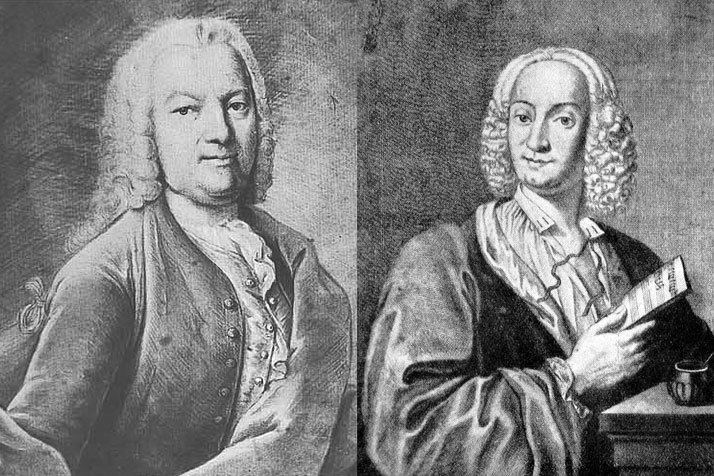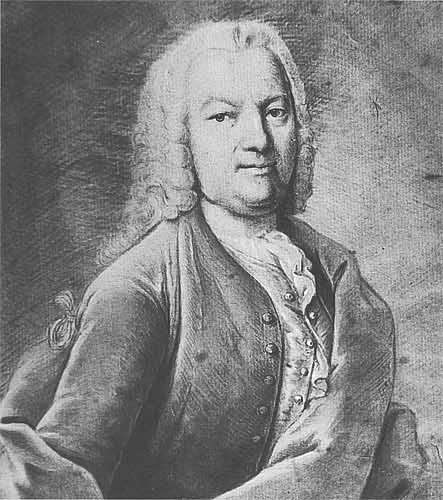


Johann Georg Pisendel was a German Baroque musician, violinist and composer who, for many years, led the Court Orchestra in Dresden, then the finest instrumental ensemble in Europe.
Johann Georg Pisendel (* 26. Dezember 1687 in Cadolzburg; † 25. November 1755 in Dresden) war ein deutscher Violinist und Komponist des Spätbarock.
Pisendel wurde als fünftes Kind einer Kantorenfamilie im zum Markgraftum Brandenburg-Ansbach gehörenden Cadolzburg geboren. Sein Vater entstammte einer Färberfamilie aus Markneukirchen im Vogtland.
Nach erstem musikalischem Unterricht durch den Vater kam Johann Georg Pisendel 1697 als Kapellknabe in die Ansbacher Hofkapelle, wo Francesco Antonio Pistocchi und Giuseppe Torelli seine Lehrer waren. Trotz der Reduzierung der Hofkapelle von 1703 wurde er wenig später als Violinist angestellt. Im März 1709 reiste er über Weimar, wo er Bach kennenlernte, nach Leipzig.
Im Jahr 1710 leitete er in Vertretung Melchior Hoffmanns das Collegium musicum. Eine 1711 unternommene Reise brachte die persönliche Bekanntschaft mit Georg Philipp Telemann in Eisenach und mit Christoph Graupner in Darmstadt.
Von Januar 1712 bis zu seinem Tod war Pisendel zunächst erster Violinist und seit 1728 Konzertmeister der Dresdner Hofkapelle.
Von mehreren Reisen war seine Italienreise (1716/1717) am bedeutungsvollsten. In Venedig verbrachte er auf Kosten seines Fürsten ein Jahr bei Vivaldi, mit dem ihn bald eine herzliche Freundschaft verband. Vivaldi widmete ihm vier Sonaten, fünf Konzerte und eine Sinfonia. Diese sind vermutlich zwischen 1717 und 1720 entstanden und tragen die Widmung „fatte p. Mr. Pisendel“; die Originale befinden sich in der Sächsischen Landes- und Universitätsbibliothek (SLUB) in Dresden.
Nach der Rückkehr nach Dresden betrieb er noch Kompositionsstudien bei Johann David Heinichen. Pisendel hinterließ einige Violinsonaten und Violinkonzerte. Er wurde auf dem Johanniskirchhof in Dresden beerdigt, sein Grab ist nicht erhalten.
Pisendel war der bedeutendste deutsche Violinvirtuose des Spätbarock. Durch großes geigerisches Können, hohe charakterliche Qualitäten und ausgezeichnete pädagogische Fähigkeiten erwarb er sich früh Anerkennung und Freundschaft zahlreicher bedeutender deutscher Musiker seiner Zeit, unter ihnen Georg Philipp Telemann. Seiner Tätigkeit als Konzertmeister unter dem Dirigenten Johann Adolph Hasse verdankte die Dresdner Hofkapelle in der Zeit des „Dresdner Barock“ ihren europäischen Ruhm. Die nach 1717 einsetzende bedeutende Vivaldi-Pflege in Dresden ist dem Wirken Pisendels zu verdanken.
Zu Pisendels bedeutendsten Schülern gehörten Johann Joachim Quantz, Joseph Riepel und Johann Friedrich Agricola. Letzterer war der Verfasser der umfangreichsten Biografie Pisendels, die er aber 1767 anonym durch Johann Adam Hiller veröffentlichen ließ.
Werke (Auswahl)
Pisendels Handschriften liegen in der Dresdner Landesbibliothek. Pisendels Werke wurden 1955 durch den Musikwissenschaftler Hans Rudolf Jung thematisch katalogisiert. Die Verzeichnisnummern werden zitiert in der Form „Jung“, römische Zahl für die Werksgattung, Schrägstrich und laufende Nummer sowie Kompositionsjahr. https://de.wikipedia.org/wiki/Johann_Georg_Pisendel
Composer: Johann Georg Pisendel, Silvius Leopold Weiss Artists: Thomasz Aleksander Plusa (violin), Robert Smith (cello), Earl Christy (lute), Ere Lievonen (harpsichord)
Johann Pisendel was the German violinist of his age; one whose total mastery of the instrument, and its expressive possibilities as filtered through both the Italian and German styles prevalent in the high Baroque era, made a fundamental impression on both Telemann and Bach. Without Pisendel, it is fair to say, there would be no Sonatas and Partitas for solo violin; Pisendel’s own fiendish unaccompanied sonata served as a model to Bach and survives partially in a publication by his great friend Georg Philipp Telemann. As is the case with Bach, Pisendel’s ‘accompanied’ violin sonatas, in which the violin is joined by a continuo ensemble, are scarcely less demanding. They, too, are four-movement works, often in the classic slow-fast-slow-fast pattern laid down by Geminiani and Corelli and doubtless taught to Pisendel when he was a boy in Ansbach by Giuseppe Torelli, a musician in the court chapel and a fine composer in his own right. Further instruction was provided by the powerfully individual leader of music at the court chapel in Dresden, Johann David Heinichen; throughout his career, Pisendel enjoyed happy association, often close friendship, with the great composers of his day; later in life, these included both Telemann and Zelenka. Perhaps because of these associations, Pisendel set himself the highest standards in composition; unlike most of his contemporaries, he subjected what he wrote to continual correction and revision, which may also account for the relatively succinct nature of his output. Four such sonatas are presented here, and divided from each other by movements from the many lute sonatas by Pisendel’s exact contemporary Sylvius Leopold Weiss. They are played here by the young Czech early-music virtuoso, who in his own, extended booklet notes, gives an account not only of Pisendel’s life and work but also of his affinity with this music: ‘Each one was as surprisingly beautiful as the previous, and no less unique… [in Pisendel] the idiom of the violin is brought to its peak.’ Johann Georg Pisendel (1687-1755) was born into a musical family (his father was Cantor), and from an early age he received lessons as a chorister and in violin, his teacher being the famous Giuseppe Torelli. Further studies brought him to Weimar where he met Johann Sebastian Bach (his near-contemporary) and Leipzig, where he met Telemann. In 1712 he joined the famous court orchestra of Dresden, where he stayed till his death in 1755. The acquaintance and friendship of the two musical giants of the time, Bach and Telemann, left a firm imprint on him as a composer and violinist. On the other hand Pisendel’s astonishing virtuosity influenced Bach to a great extent, Bach’s solo violin sonatas & partitas would not have been the same without Pisendel. This new recording presents three violin sonatas and one violin solo sonata by Pisendel, works of staggering technical demands, rich in harmony and freedom of expression. As interludes we hear solo lute works by Silvius Leopold Weiss. Played with immense dedication and conviction by young Polish violinist Tomasz Aleksander Plusa, who studied with Lucy van Dael, Christoph Rousset, Simon Standage, Sigiswald Kuijken and others.
